For additional information relating to this article, please contact:
March 23, 2017NOVA SCOTIA QUARTERLY POPULATION ESTIMATES AS OF JANUARY 1, 2017 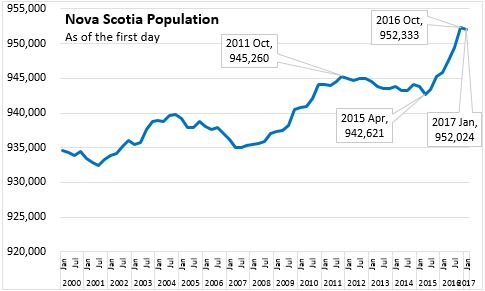
Nova Scotia’s population decreased by 309 between October 1, 2016 and January 1, 2017. The population as of January 1, 2017 stands at 952,024. This is the second highest population estimate reported in Nova Scotia, just below the high of 952,333 on October 1, 2016. Since January 1, 2016 Nova Scotia's population has increased by 6,174.
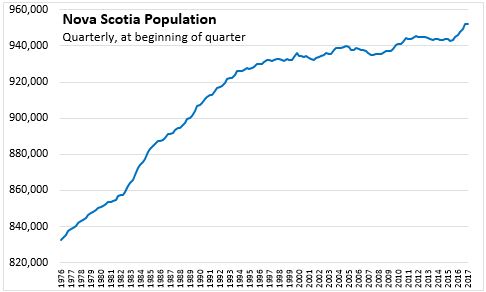
There are seasonal patterns in quarterly population changes, particularly evident in births and international migration. The fourth quarter is often a slow or negative growth quarter for population in Nova Scotia. The most recent population decrease of -309 is the largest decline for the fourth quarter of the year since 2012.
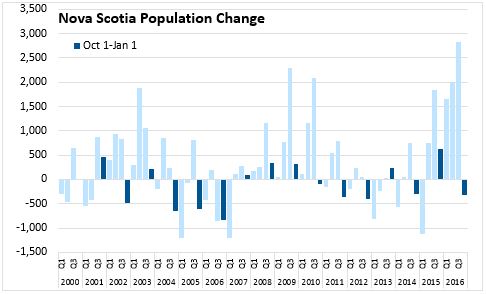
Population growth in Nova Scotia is typically slower than the national average pace. In the last quarter, Nova Scotia’s net population decrease amounted to 0.03 per cent of the population as of October 1, 2016. The national population grew by 0.16 per cent over this period. Compared with January 1, 2016 Nova Scotia’s population has increased by 0.65 per cent while the national population grew by 1.29 per cent.
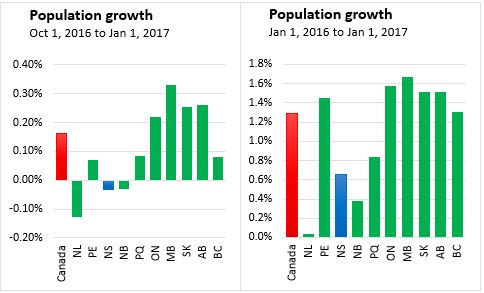
In recent quarters, immigration from other countries has been a strong contributor to population growth in Nova Scotia. Nova Scotia received 939 immigrants during the fourth quarter of 2016. This is the largest influx of immigrants in the fourth quarter of the year since 1973.
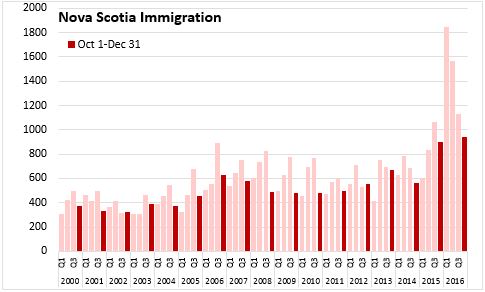
Nova Scotia’s ‘natural’ population change (the number of births, less the number of deaths) has been negative for several years, with the exception of the regular Q3 increase in births. Q1 is regularly the quarter with the lowest natural population change of the year, as a result of the regular Q1 decrease in births. Between October 1, 2016 and January 1, 2017, there were 2,110 births and 2,343 deaths, amounting to a natural population decrease of 233.
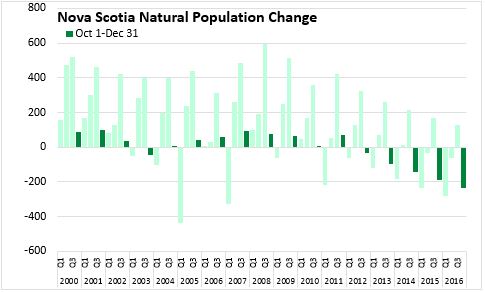
Interprovincial migration has typically been a drain on Nova Scotia’s population. From October 1, 2016 to January 1, 2017 there was a net outflow of 40 interprovincial migrants from Nova Scotia, compared to a gain of 164 during the same period of the previous year.

There has been a shift in patterns of interprovincial migration in the fourth quarter of 2016 compared to the fourthquarter of recent years. Outmigration from Nova Scotia to Alberta and Newfoundland and Labrador slowed, while more Nova Scotians left for Ontario and British Columbia.
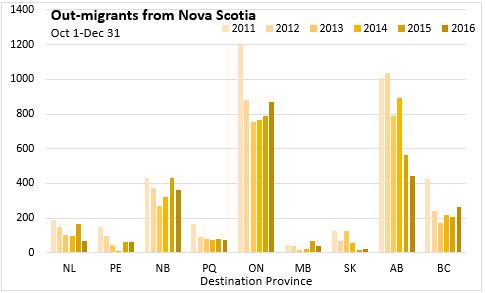
Among those coming to Nova Scotia from other provinces, in-migration from Alberta and Newfoundland and Labrador remained elevated while in-migration from Prince Edward Island, New Brunswick, and Ontario declined.
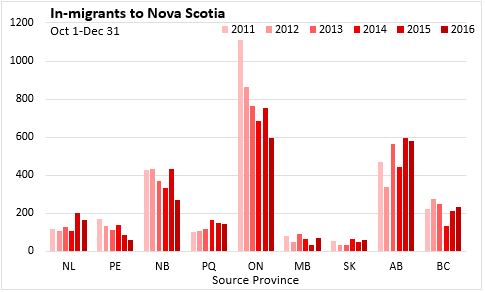
In aggregate, net interprovincial migration to Nova Scotia from Alberta and Newfoundland and Labrador has improved while net interprovincial migration with Prince Edward Island, New Brunswick and Ontario has declined.
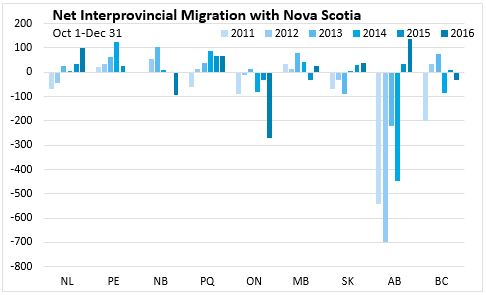
The net increase in the number of non-permanent residents in Nova Scotia has been a significant contributor to population growth over the past two years. The fourth quarter is often a quarter of slow or negative growth in NPRs as a result of permits expiring at the end of the calendar year. In the fourth quarter, net-NPRs declined by 817. This was the largest single quarter decrease in non-permanent residents living in Nova Scotia on record, though it follows two years of relatively rapid increase.
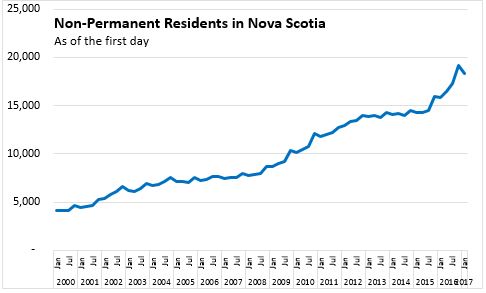
Annual Jan 1, 2016-Jan 1, 2017
From January 1, 2016 to January 1, 2017, the Nova Scotia population grew by 6,174. Over the course of the year, 9,168 deaths outweighed 8,720 births for a net natural population decrease of 448. This continues the trend of declining natural population growth since 2008.
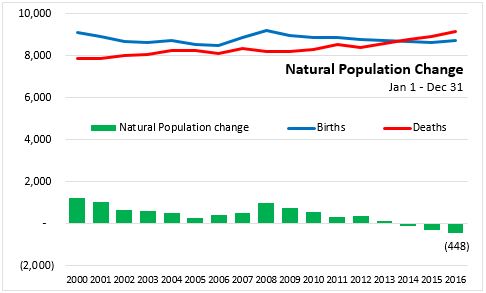
During 2016, the province received 16,443 migrants from other provinces and lost 17,123 migrants to other provinces, for a net interprovincial migration of 680. This continues a trend of improving interprovincial migration since 2012 and represents the lowest net outflow to other provinces since 2010.
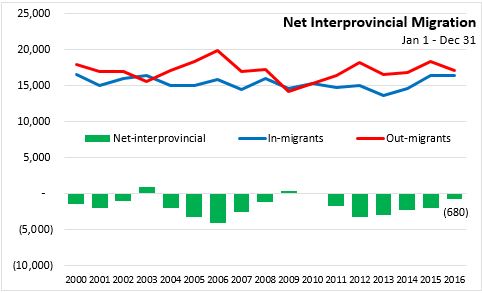
2016 was a record year for international migration to Nova Scotia with 8,582 international migrants, including record numbers of immigrants (5,484) and net non-permanent residents (2,475), compared to an international outflow of 1,280. Net international migration to the province was 7,302 in 2016.
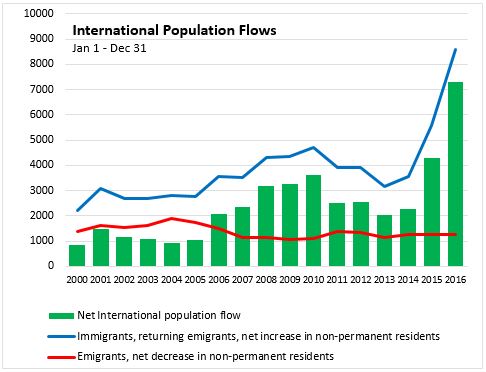
Statistics Canada Cat. No. 91-215
Source:
Quarterly Demographic Estimates, Statistics Canada. Pub 91-002-X (free)
Statistics Canada CANSIM tables: 051-0005 (Population estimates), 051-0017 and 051-0045 (Interprovincial Migrants), 053-0001 (Births and Deaths), 051-0037 (International Migrants)